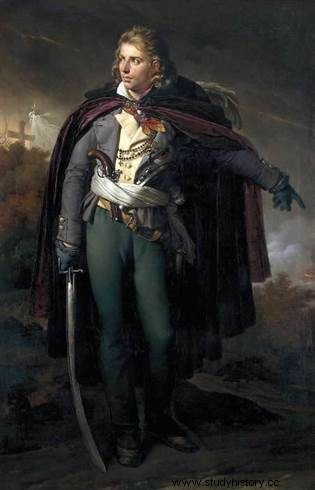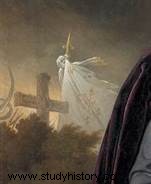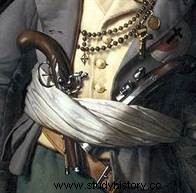 Under the Restoration, from 1816, King Louis XVIII commissioned a dozen paintings representing the great leaders of the revolt Vendée who in 1793 took the lead of a makeshift army made up of peasants to defend the Faith and the king. It is indeed the image of an active resistance, with its martyrdoms, that the king seeks to fix, to memorialize. The painting by Jacques Cathelineau , a simple commoner who became the first generalissimo of the Catholic and royal army, was entrusted to Girodet. Far from delivering only a pale picture to satisfy the political expectations of the monarchy, the painter exalts this tragic destiny in a style where neo-classicism opens at the dawn of pictorial romanticism. A masterpiece that can be seen today in Cholet, a city deeply marked by the Vendée wars.
Under the Restoration, from 1816, King Louis XVIII commissioned a dozen paintings representing the great leaders of the revolt Vendée who in 1793 took the lead of a makeshift army made up of peasants to defend the Faith and the king. It is indeed the image of an active resistance, with its martyrdoms, that the king seeks to fix, to memorialize. The painting by Jacques Cathelineau , a simple commoner who became the first generalissimo of the Catholic and royal army, was entrusted to Girodet. Far from delivering only a pale picture to satisfy the political expectations of the monarchy, the painter exalts this tragic destiny in a style where neo-classicism opens at the dawn of pictorial romanticism. A masterpiece that can be seen today in Cholet, a city deeply marked by the Vendée wars.
Anne-Louis Girodet
Born in Montargis in 1767, Girodet joined David's studio in 1785. He was to be one of his most brilliant pupils and carried high the colors of neoclassical painting inherited from his master. Very affected by the death of his parents in 1784 and 1787, the young Girodet became the protege of Doctor Trioson. The latter finally adopted it in 1809, from then on the painter called himself Girodet de Roucy-Trioson, or more simply Girodet-Trioson. Disqualified from the Prix de Rome in 1787, he won second place in 1788 (with "La mort de Titus ”) and first place in 1789 (with “Joseph, recognized by his brothers "). The laureate then stayed in Rome until the exclusion of the French by the Papal States in 1793. He nevertheless remained in Italy until 1795, when he returned to Paris where he excelled in the paintings of various personalities:Jean- Baptiste Belley, Mademoiselle Lange, Napoleon during his Consulate, Chateaubriand… To the neoclassical style inherited from David, Girodet adds a hint of romanticism which makes him one of the precursors of this movement applied to painting. Does the student surpass the master? In 1810 his painting on the Deluge stole first place in the Prize for the Decade from David... Inheriting a fine heritage two years later, Girodet devoted himself to poetry, but did not neglect painting for all that, since he took part in the decoration of the castle of Compiègne. The year 1816 is the one that concerns us more specifically in the life of Girodet, he was then appointed professor at the Beaux-Arts in Paris and the new French monarch will give him a historico-political order:full-length painter General Jacques Cathelineau, first Generalissimo of the Catholic and Royal Army in 1793.Painting the first Generalissimo of the Catholic and Royal Army
 Like the painting of Louis de Lescure by Robert Lefèvre, the painting of Cathelineau by Girodet is part of the series of paintings by Vendée generals commissioned by Louis XVIII in 1816. The aim was always to highlight the heroes of the Counter-Revolution, their resistance, their courage, their religiosity and their sacrifice for the throne and the altar.
Like the painting of Louis de Lescure by Robert Lefèvre, the painting of Cathelineau by Girodet is part of the series of paintings by Vendée generals commissioned by Louis XVIII in 1816. The aim was always to highlight the heroes of the Counter-Revolution, their resistance, their courage, their religiosity and their sacrifice for the throne and the altar.
However, the portrait of Cathelineau is not without its problems… Indeed, although Generalissimo of the Catholic and Royal Army, although considered holy by some, this figurehead of the Vendée revolt did not leave a portrait and his features seem to have disappeared with him in the grave. Indeed, a simple commoner, Cathelineau had not benefited from the services of a painter and his early death in 1793 had not left time for some of his companions to immortalize his face. To compensate for this lack of sources, Girodet will call on the testimonies and descriptions of witnesses who knew the "saint of Anjou" well. At the origin of the order, the Comte de Pradel, Director General of the Ministry of the Household of the King, entrusted him with this description:
“ Mr. Jacques Cathelineau General:
Dressed as a peasant, large jacket with large pockets and pale blue gray breeches, double-breasted white wool waistcoat, a white canvas belt in which was placed a pair of pistols; a hussar saber; a sacred heart sewn on the habit, on the heart; the Sacred Heart is a square piece of white cloth on which is a red heart and a black cross above; a rosary passed through several buttonholes.
A tie of a Cholet handkerchief, purple and white, a handkerchief similar to the head, tied Vendée style. Hat point. Leather gaiters, very common shoes. Holding his saber lowered, showing with the other hand, as a sign of rallying, a cross placed in the landscape of the painting, so that General Cathelineau has a lot of energy and liveliness; and the countenance very gentle, but very animated. You can make a portrait on the face of your son who looks very much like him; but his eyes were bigger. His countenance, though gentle, was extremely lively and witty .

 The whole background seems to correspond to Comte de Pradel's request, but the few tracks data have been magnified by Girodet. The upper left corner of the painting evokes the revolt of the Vendée people (scythes, sickles and other bladed weapons brandished) united within the Catholic (Christian cross) and royal army (white flag waving in the wind with fleur-de-lis flagpole).
The whole background seems to correspond to Comte de Pradel's request, but the few tracks data have been magnified by Girodet. The upper left corner of the painting evokes the revolt of the Vendée people (scythes, sickles and other bladed weapons brandished) united within the Catholic (Christian cross) and royal army (white flag waving in the wind with fleur-de-lis flagpole).
The violence of the Republic and its armies, the tumult of revolt and battle, are symbolized by the unleashing of the forces of nature:the stormy wind pushes the branches, unfurls the flag, the lightning tears the background and echoes the volleys fired in the lower part of the painting from which emerges the smoke of the battle. Cathelineau points a graceful hand and a determined finger towards the battlefield, calling to battle those who follow him and to whom he turns. The lightning forms a line parallel to his arm passing at the level of his eyes, so much so that the generalissimo seems to direct the lightning on the republican armies while keeping a soft, but electric look. He himself remains unshakable, like the rocks that surround him. The darkness of the cape, the clouds in the upper part, and the rocks in the lower part, contrast with his chest offered to an intense light highlighting the sense of combat and sacrifice of this man:the pistols symbol of the Vendée revolt to defend the Faith (embodied by the rosary) and restore the king to the throne (symbolized by the white scarf).

In conclusion, Girodet used for this painting elements that seem authentic, at least as they had been reported to him through the Comte de Pradel. But the details carry a message that makes it much richer than a simple historical cliché:without any other combatant appearing, Girodet succeeds in evoking the violence and designs of the Wars of Vendée, the tumult of revolt and the war. In these dark hours where darkness reigns Cathelineau appears like a meteor illuminating the conflict by the purity of his motivations displayed on his chest, striking down the Republican armies by ordering men like lightning! But like any meteor, it is destined to burn itself out by illuminating Men and already the cape seems to be closing on it like a death sheet...
The painting was exhibited at the Salon of 1824:the painter Charles-Paul Landon, art critic and curator of paintings at the Louvre, underlined "the energy of the brush, the liveliness of the expression and this beautiful finish that distinguishes all the works of Girodet ". The same year the painter succumbed and was buried in the Père-Lachaise cemetery. The painting was sent to the Palace of Saint-Cloud before joining Versailles in 1914 and finally the Museum of Art and History of Cholet where it can be admired today.
